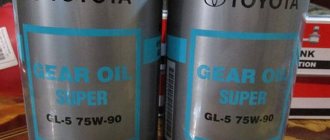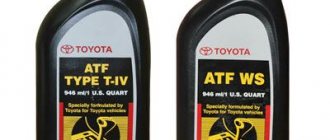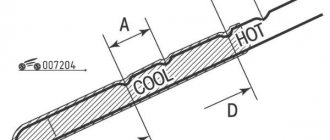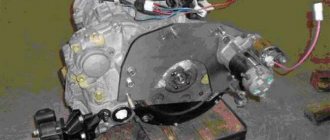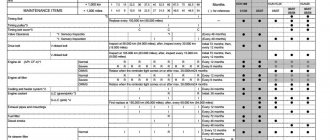18.12.2019
| (Votes: 2, Rating: 3) |
Issues discussed in the material:
- How often should you change the oil in a Toyota Camry automatic transmission?
- How to check the oil level and condition in a Toyota Camry automatic transmission
- What oil to fill and how to choose it correctly
- How to partially change the oil in a Toyota Camry automatic transmission (step-by-step instructions)
- How to completely change the oil in a Toyota Camry automatic transmission using a machine
- What do car owners think about changing the oil in a Toyota Camry automatic transmission?
Changing the oil in a Toyota Camry automatic transmission is an important procedure that must be carried out regularly as part of vehicle maintenance. Of course, the manufacturer officially claims that the oil in Toyota automatic transmissions is maintenance-free and does not need to be changed. But in difficult Russian operating conditions, such advice can lead to serious damage to the gearbox.
Professional auto mechanics and even employees of dealer service centers unofficially advise checking the oil in the Toyota Camry automatic transmission for quality every 40–50 thousand kilometers and changing it if necessary. Next, we will talk in detail about how to determine that the oil has become bad and what constitutes a partial and complete replacement of the lubricating fluid.
The main mistakes of car owners
Most Camry owners encounter difficulties already at the stage of checking the oil level in the box. Although it is enough to carefully read the car’s operating instructions to avoid serious mistakes.
When checking the oil, it is necessary that the level matches the marks on the dipstick.
It is worth noting that for automatic transmissions, operation with both a low ATF level and its “overflow” is equally dangerous. And if in the first case the wear of all automatic transmission components increases significantly, then in the second there is a high probability of oil squeezing out through the seals or gaskets.
Replacement frequency
The manufacturer prescribes an inspection check of the oil in the gearbox crankcase every 2 years of operation or 40 thousand kilometers. The fluid should be replaced after 4 years (or 80 thousand kilometers) or if the technician detects cloudiness or metal shavings.
The manufacturer does not regulate the service life of the material. The condition of the oil is affected by operating conditions: in Russia it is recommended to drain the old fluid every 60 thousand km.
Signs indicating the need for early service:
- jerks or delays when switching steps up or down;
- detection of metal shavings on the probe;
- darkening of the liquid or appearance of a burnt odor.
Pouring oil into the gearbox on Camry 40
You can change the automatic transmission oil by following the instructions below.
Unscrew the drain plug.
Wait until the oil drains.
Unscrew the pallet fasteners.
The machine is not able to release all the oil through the drain hole. Therefore, after dismantling the pan, oil will run onto it for some time.
Remove the pan into which some of the lubricant has escaped.
Place the new filter in place.
Close the drain hole with a bolt. In this case, it is necessary to use a new seal.
Remove the return hose. Place a container and drain the oil.
Add fresh oil.
How to distinguish an original from a fake
The main signs of a fake:
- the barcode field and the factory label on the back wall of the container are painted white instead of gray;
- the weld seam has a gap between the sheets, on the original can the joint is smooth with an overlap;
- the letters on the front part are light in color; the original uses gray paint;
- the handle is welded with a distortion, genuine products have neat welding;
- the cork after opening does not ensure the tightness of the container;
- The color of the fake is less saturated, the original is painted in a bright pink hue.
Checking the oil level in the Toyota Camry automatic transmission
Depending on the type of gearbox, checking the oil level of the Toyota Camry 2014 automatic transmission is carried out in several ways:
Important! If a critical drop in level is detected, you must immediately fill in a new substance with similar characteristics and contact a repair service. The presence of drips and loss of product indicates a malfunction of the unit and the presence of a minimum of microcracks, and a maximum of failure of oil seals or other parts.
Use of special equipment
When servicing the box in a service center, it is necessary to disconnect the hoses from the oil cooler. One line is connected to the pumping station, and the second is discharged into a reservoir for collecting waste. The pump forces fresh fluid into the crankcase until clear red oil begins to flow out. The advantage of the technique is the complete displacement of waste material from the crankcase.
It should be borne in mind that fresh fluid washes away deposits of wear products that enter the hydraulic system and clog channels and valves. There may be jerks or pauses during shifting, accompanied by a change in the crankshaft speed. To restore functionality, you will need to disassemble the unit and flush the hydraulic unit. The increased volume of liquid used when flushing should also be taken into account (50-70% more than the nominal capacity of the crankcase).
Transmission oil change interval for Toyotas
The drilling change interval depends on the driver's driving style. For example, sudden starts on the gearbox are prohibited. Because the lubricant does not have time to form a protective layer on the mechanical components of automatic gearboxes.
Cold starts in winter lead to a major overhaul of the Toyota automatic transmission after a year of driving. Because the oil is not warmed up, it is viscous, it has not yet taken its shape to be able to protect the machine from rapid wear.
It is important not only to regularly replace it, but also to check the amount of lubricant. A decrease in oil level leads to:
The transmission change intervals in Toyota automatic transmissions are as follows:
Attention! The transmission quantity is checked every 10 thousand kilometers. And on a recently purchased car, you can drive more than one hundred thousand kilometers before you need to change the engine for the first time. The first replacement of lubricant in a Toyota automatic transmission is done completely.
In addition to checking the amount of lubrication and maintaining intervals, it is important to buy high-quality original oil. Non-originals destroy the machine gun in the shortest possible time. Therefore, next we’ll talk about what oils are used in Toyota transmissions.
If you have any questions about working shift intervals, you can ask them in the comments.
Practical advice on choosing oil in a Toyota automatic transmission
Original Toyota gearbox oil can always be distinguished by its hard plastic and non-blurred inscriptions on the product sticker. Only such a lubricant can protect the automatic transmission from problems with it and major repairs.
The original oil does not lose its level as quickly as a non-Chinese counterfeit does. An automatic transmission manufacturer will never flood someone else’s transmission, which in terms of technical properties does not correspond to the developments of Toyota engineers.
So, let's look at what transmissions need to be filled and what is the level or displacement for a Toyota transmission.
Original oil
Original Toyota transmission lubricants include the following fluids:
These oils do not interact with rubber gaskets and seals of automatic transmissions and have a stable viscosity index. The automatic machine does not overheat in the summer and when traveling on dirt roads and country trails.
Analogs
Of the analogues, I can recommend Aisin ATF AFW. According to the specifications, the lubricant is compatible with the original transmission fluid. It has an increased viscosity index and does not freeze at temperatures of minus 45 degrees below zero.
Mobil ATF 3309 from an American company. Also fully compatible synthetic oil. It has proven itself well among experienced car owners.
Having decided on the choice of oil, we proceed to checking the lubricant level in the automatic transmission.
Checking the level
Checking the lubricant level should always begin with warming up the car. It is not recommended to increase or decrease the level. Automatic transmissions do not like such actions.
Since Toyota automatic transmissions are available with dipstick and without dipstick, the algorithm for checking the oil level in the automatic transmission will also depend on the modification of the automatic transmission. Let's take a closer look at the examples I will give below.
With dipstick
Let's look at how the level is checked in automatic transmissions that are equipped with a dipstick. Such automatic transmissions are easily controlled by beginners, because it is easier to check the level on the dipstick than to crawl under the car and unscrew the control plug.
If the oil corresponds to the level marked “Hot” or “Max,” then there is enough transmission fluid in the machine. If it is lower, then you need to top it up. Just don't overdo it.
Excessive levels of lubricant are just as harmful to the gearbox as underfilling. Excess oil will be squeezed out by the breather, resulting in air entering the system. And this will lead to the fact that the box may go into emergency mode.
Underfilling is also dangerous. The automatic transmission will overheat even in the cool season. The clutches will burn out, the machine will knock, kick, and push.
Attention! An automatic transmission system in good condition requires no more than 0.5 or 1 liter to top up to the desired level.
Now let's look at how to check the transmission fluid level in an automatic transmission without a dipstick.
Without dipstick
In a box without a dipstick, checking the level will be more difficult for beginners. We do the procedure this way:
If it is dry, then the transmission fluid level needs to be replenished. Check the oil level when the automatic gearbox is warmed up to a temperature of 35, 45 degrees above zero.
Boxes for Toyota Camry
Samples of cars of this model were equipped with different automatic transmissions - 4, 5 and 6 stages, depending on the year of manufacture, body type and power unit power. Boxes from Aisin are distinguished by unpretentiousness to operating conditions, a long “life” and good reliability of the elements, subject to timely and correct maintenance.
Important: there are models with a CVT, mostly Japanese-made cars of the 8th and 9th generation Camry.
For example: since 2009, Camrys with 3.5-liter engines have used an Aisin U660E 6-speed gearbox. This box is also found in Lexus LS cars. Complete with weaker 2.5 liter engines. often comes automatic U760E.
U660E box removed:
Summary table of Toyota Camry automatic transmission models by year of manufacture, engine size and drive:
Depending on the model, there are boxes:
Box operating modes
The automatic transmission model and control method (hydraulics, electronics) determine the set of its operating modes. Regardless of the type of transmission on the Camry, there are several main modes:
Important: you cannot switch to this mode until it stops completely. Also, when stopping on uphill/downhill slopes, you should first tighten the handbrake, and only then put the box into parking mode.
There may also be additional buttons on the lever - Overdrive (O/D), SNOW, PWR, MANU, NORM.
Changing the automatic transmission oil - BMW X 5
One of the options for the Overdrive button:
Important: Toyota automatic transmissions have a locking system to avoid damage from improper operation. Thus, you can remove the transmission from “parking” or engage reverse gear only after stopping, with the brake pedal depressed and the unlock button on the lever pressed (if equipped).
As you can see, there are “+” and “-” symbols: this means that the box can operate in “manual” mode, when the driver himself tells the box when to downshift or upshift. This mode is close to the operation of classical mechanics.
Main problems and malfunctions
Let's look at the typical problems of Camry gearboxes using the example of the U760E automatic transmission installed in Camry V50 cars.
U760E is a modification of the Aisin U660 family of gearboxes, devoid of some design flaws and designed for engines up to 2.7 liters in volume (there is also the U760F option: the letter F indicates the purpose of the box for all-wheel drive minivans and crossovers).
The main problem with these boxes is the torque converter. What breaks:
Other problems may also arise, especially on boxes with high mileage. On average, the service life of the gearbox hydraulic unit before overhaul is about 200 thousand, but timely maintenance of the box can significantly extend it. So, it is advisable to change the above lining after 150-200 thousand, which will allow you to postpone the overhaul.
In general, it can be noted that the U760E box turned out to be more successful compared to the more powerful 660 series; a number of shortcomings and “childhood diseases” were corrected in this box.
Therefore, with proper maintenance and proper operation, the gearbox is capable of operating the required 200 thousand without major repairs, and in some cases, without changing the oil.
But the latter is still a rarity, since a timely and correct oil change in the automatic transmission of a Toyota Camry in modification 50 is the key to the long life of the gearbox.
Oil change
Toyota states that the transmission oil is conditionally non-replaceable, i.e. filled for the entire “life” of the box.
In practice, automatic transmission oil inevitably becomes contaminated with metal fragments formed during operation and loses its properties due to wear and tear over time.
In Russian realities, it is advisable to change ATF every 30-40 thousand kilometers, although it is officially recommended to do this after 50 thousand.
You can verify the need for replacement by visually checking its condition. This is usually done using the automatic transmission dipstick (the location of the dipstick is indicated in the car manual).
Important: in some Camry variations (40, 50 models) there is no automatic transmission dipstick, but you can check the level and color through a special inspection hole in the pan, which will be discussed in more detail later. On these Camry models, changing the automatic transmission oil also has some features.
To check, the car warms up (you can take a short trip or switch all the gearbox modes one by one), place it on an overpass or pit, after which the gearbox is switched to N, and the control hole plug is removed.
A little oil should leak out from there, which determines the quality of the fluid: if nothing leaks out, the oil level in the box is low and requires topping up or replacing the whole thing.
When checking with a dipstick (if there is one), you need to “drive” the transmission modes and check what level the transmission oil is at.
Attention: when checking with the engine running, the oil will be hot!
Changing the oil in the automatic transmission of a Toyota Camry 50 version will require about 12-15 liters of fluid completely, and for a partial oil change - 6.5-8 is enough. It is advisable to use the original, or select the liquid that best suits the tolerances for the box.
It is also advisable to purchase:
Automatic transmission friction discs - Design and principle of operation
You can also replace the drain plug gasket (90430-18008) and the box filter gasket (90301-32010).
Prepared set of parts for replacement (filter, gaskets):
Partial replacement
You will need new oil, a set of gaskets and a filter (see above), tools, and a graduated container for working out.
Algorithm of actions for changing the oil in a Toyota Camry automatic transmission:
Next, the fastenings of the box pallet are loosened:
The oil that flows out is also collected in a container. As a result, the pan needs to be removed and the remaining oil drained from it.
Box with pallet removed:
After this, you need to inspect the box filter; if necessary, it should also be replaced. During the process, some more oil will leak out, which needs to be collected in the same container.
The pan is washed from the remains of old oil and waste (chips, etc.). The gasket is inspected, if it is in good condition, it can be left; if the box pallet gasket is worn out, it is replaced.
Washed box pallet:
Important: the tube in the picture is an element of the oil level control system without a dipstick. If the oil in the box is higher than the level determined by the bypass tube (taken as normal), it will pour out when the plug is unscrewed.
Since there is no dipstick, the filler neck is not under the hood, but in the area of the front left wheel, under the plastic body kit:
Fill the oil with a special syringe, hand pump, or other available devices.
After oil begins to flow from the bypass tube, stop filling, tighten all the bolts and plugs, “run” the transmission modes again to disperse the oil through the system, and make a control measurement, adding fluid to the box if necessary.
This completes the replacement.
Complete replacement of fluid in a Toyota Camry automatic transmission
It is recommended to do a full change at specialized service stations, using special devices that circulate the oil in the box under pressure. A complete replacement can take up to 15 liters of ATF.
Box operating modes
The automatic transmission model and control method (hydraulics, electronics) determine the set of its operating modes. Regardless of the type of transmission on the Camry, there are several main modes:
- P – parking mode. It should be chosen when parking for a long time. The gearbox is turned off, the shaft is blocked, and the drive wheels do not rotate.
Important: you cannot switch to this mode until it stops completely. Also, when stopping on uphill/downhill slopes, you should first tighten the handbrake, and only then put the box into parking mode.
- R – reverse gear. You can transfer to it from “parking” and “neutral” only after stopping the car.
- N – neutral mode. The box does not transmit torque to the wheels, but the shaft is not blocked and the drive axles can rotate. In this mode, the car can be towed over a short (important!) distance.
- 2 – movement is blocked in gears above 2. This gearbox mode is suitable for bad roads, frequent ascents and descents, since it uses engine braking.
- L – low gear. It is recommended to use it on steep slopes and off-road; in it, Toyota moves only in 1 transmission stage.
- D – main mode of the box, forward movement.
There may also be additional buttons on the lever - Overdrive (O/D), SNOW, PWR, MANU, NORM.
- NORM/PWR – switches transmission modes from normal to sports. In the second, the gear shift logic changes, the car becomes more dynamic, but consumes more fuel.
- SNOW – “winter” mode, in which the car starts from 2nd gear, making it easier to start driving on ice and snow.
- MANU button – found mainly on Toyota, similar to Snow.
- Overdrive – permission to use overdrive. When overdrive is active, the car is allowed to switch to the last gear (5, 6...); when overdrive is disabled, it is not. Many people recommend turning off overdrive in the city cycle to increase the service life of the box.
Request a call
The oil in an automatic transmission is changed in two ways - partial or complete replacement. Partial replacement is carried out by draining the old oil and adding new oil. In this case, the pan is removed, washed, the filter and pan gasket are changed. With a partial change, changes from 35% to 45% of the oil
in the automatic transmission and eventually it all mixes, forming an average mass of old and new oil.
When completely changing the oil in an automatic transmission, 100% of the oil is replaced using the device
.
This happens by flushing and replacing - the old oil is drained from the sump, the sump is removed, the filter is washed and changed. The sump is closed. New oil is supplied to the automatic transmission under pressure in a certain quantity, then the engine is started and the full cycle is carried out with the engine running.
, the old oil is pumped out and new oil is supplied at the same time. You can read more about the principle of operation here.
A complete oil change in an automatic transmission is carried out using a special device for a complete oil change in an automatic gearbox.
Complete oil change in automatic transmission Toyota Camry
For a complete oil change, we will need 12 liters of original Toyota WS class automatic transmission oil, a pan gasket and an automatic transmission filter.
We drain the oil from the automatic transmission pan and dismantle the pan itself.
As you can see in the photo, there is dirty oil in the automatic transmission pan - this is a consequence of untimely oil change in the automatic transmission, as a result of which metal shavings are observed on the magnets. This indicates that there is mechanical wear in the automatic transmission, which in the future can damage the automatic transmission.
We wash the automatic transmission pan from old oil and remnants of the old gasket, and install a new gasket.
Install a new automatic transmission oil filter and close the pan. After this, the procedure for draining the oil begins using a special device for changing the oil in an automatic transmission. It is connected to the oil cooling circuit in the automatic transmission.
First, add a certain amount of oil to the automatic transmission with the engine not running, then carry out the main cycle with the engine running. After the end of the cycle, the device is disconnected and the oil level in the automatic transmission is adjusted.
That's it for changing the oil in the Toyota Camry automatic transmission.
finished.
Automatic Camry
Toyota Camry cars are reliable, subject to competent and timely maintenance of components and mechanisms. It is especially important to change transmission lubricant not only after a certain mileage, but also as needed.
This is especially true for those Camry cars that were equipped with a u660e automatic transmission. This unit was installed on luxury versions with a 6-cylinder V-shaped engine of 3.5 liters.
To feel the full power of the iron horse, you need to ensure a comfortable ride without jerks, jolts and slight “thoughtfulness”, which is characteristic of a faulty gearbox.
What malfunctions threaten a luxury box on a Camry?
The u660e 6-speed automatic transmission is considered one of the best designs among similar units. It has a smooth ride and better dynamic characteristics than a manual transmission.
With proper maintenance, the Toyota Camry transmission of the luxury version is also highly reliable.
The only problem that can cause malfunctions is “whimsicalness” regarding the quality of consumables.
A few years later, the developers offered consumers a modification of the u760e, which was equipped with all-wheel drive versions of crossovers and sedans. This model is also durable and reliable, as it is designed for 10 years of operation or in kilometer equivalent for 200 thousand mileage. But this is subject to competent maintenance.
But the luxury Toyota Camry was not without breakdowns and other problems. As practice shows, the weak points of the u660e automatic transmission are:
It should be noted that the u660e and u760e solenoids belong to the new generation and are marked PWM. And by themselves they cause little trouble. They were listed among the weak points on the Camry because due to incorrect operation of the torque converter, clogging of parts occurs.
The problem with the bearing is structural. As the diagrams of the u660e and u760e clearly demonstrate, it is mounted on a retaining ring that cannot withstand heavy loads in an aluminum housing. And as a result, vibration occurs literally after 90 thousand km, especially on Camry versions with powerful internal combustion engines.
The valve body on the Toyota Camry automatic transmission is faulty due to the torque converter and wear of the clutch lining. If you change it and repair the torque converter at least every 120 thousand km, then serious problems and malfunctions can be avoided.
How often do you need to change the automatic transmission oil in a Camry?
Manufacturers do not indicate how many kilometers are needed to replace the lubricant in an automatic transmission, indicating that it and the unit have the same service life. But actually it is not. Manufacturers' recommendations are suitable for ideal foreign roads. Our compatriots should update the Camry's transmission lubrication every 40 - 50 thousand km.
But you should not blindly focus only on mileage, since after 10-20 thousand km malfunctions may occur due to lack of lubrication in the box. And if you wait until the car travels the same amount, then the motorist will have to fork out for expensive repairs to the Toyota Camry automatic transmission.
For this reason, you should change the oil when:
Choosing oil for automatic transmission Camry 40
Among all generations of the Camry model range, the sixth or XV40, which is so loved by our compatriots, is distinguished by its reliability. But at the same time, not everyone knows what kind of oil is needed for the automatic transmission of the 40th Toyota. Most modern motorists purchase transmission lubricant on the principle of “universal for the box”, without paying attention to the brand of the product itself and the model range of the car.
For Camry 40, you should select the lubricant recommended by the manufacturer. Such information is indicated either on the dipstick or in operating conditions. The ideal oil for Toyota automatic transmission is Tipe T-IV, developed specifically for the holding’s cars. The original WS will also work. If this lubricant is a little expensive, then you can choose one of the analogues:
However, their cost is also not cheap, especially when you consider that to completely replace the consumables, you need to prepare 3 canisters of 4 liters each.
Also on the Camry, a traditional or partial update is allowed, in which the filling volumes and replacement interval are such that the procedure itself is more expensive. Not all motorists perform such activities with the same frequency, but if we take the average, then with 30 thousand completed, “topping up” will use up about 10 liters.
Do-it-yourself oil change in automatic transmission Camry 40
Qualified technicians recommend performing a complete update of the lubricant at a service station, since the procedure requires special equipment. But there are also craftsmen who have learned to completely change the lubricant at home. To do this, you definitely need to drive the Camry onto a lift, overpass or inspection hole.
Tools and consumables for performing work
To service the box you will need the following consumables:
- Filter for liquid purification. Article number of the original element 35330-08010 (2.4 l) or 35330-33050 (3.5 l). It is possible to use analogues from JS Asakashi or Azumi, differing in cost reduced by 15-20%. A pan seal is supplied along with the cleaning elements. If the seal is not included in the kit or the part is damaged during installation, you must buy a gasket with article number 35168-21020 or 35168-33080 (2.4 and 3.5 l, respectively).
- O-ring 90301-32010. It is installed on the filter neck.
- New drain plug 90341-18016 and metal O-ring 90430-18008 (both from Toyota).
Necessary tools and equipment:
- a set of wrenches or sockets (sizes 10, 17 and 24 mm);
- 6 mm hex key;
- funnel with an installed hose for filling fresh liquid;
- container for collecting waste material;
- rags for wiping;
- gasoline or solvent to clean the pan.
Checking the Oil Level in the Toyota Camry Automatic Transmission
Scheduled maintenance always increases the shift of certain consumables. After using the car for a long time, the Japanese manufacturer advises changing the ATF fluid in the automatic transmission.
Of course, carry out a “partial”, in other words, a complete oil change.
If you want your technical service to be of high quality, and to change the oil in your Toyota Camry automatic transmission without unnecessary problems, find out how to approach this issue correctly.
Choosing ATF fluid for an automatic transmission
When choosing an oil for an automatic transmission, it is worth studying its technical properties (additives). However, in order to be measured, it is worth pouring the lubricant recommended by the manufacturer (indicated on the dipstick or in the annotation).
You will like the “Dexron 2”, “Mopar 7176”, “Type T” or “SP 2” more. What kind of liquid to fill is up to you. The cost of an unusual and recommended lubricant will be higher than for analogues of other brands.
Surely, the ideal option is the Toyota ATF Type T-IV. This high-quality automatic transmission fluid is designed specifically for Toyota cars. At the production stage, many basic consistencies are used that have the highest degree of purity. The liquid also has high-quality balanced additives.
If in your region there is no access to purchasing high-quality oil materials like Toyota, then you will have to find analogues. But it will not be easy to find oil with the same features and quality. If you are not sure which liquid to fill is much better, then just change it to “Dexron 2D” or “Dexron 3”.
Each Toyota car, of course, has its own advice; it is better to follow the developers' instructions. If you are in doubt about choosing the right oil products or, in other words, replacing them yourself, then contact a specialist car service center for help.
Types of automatic transmission fluid replacement for Toyota Camry
Traditional - partial renewal of the existing consistency. This is a simple method that will save you money, but not time. Partial change of lubricant brings several approaches. Transmission oil renewal for automatic transmission is done every 20-30 thousand. To change 30-50 percent of the oil used, a number of actions must be taken:
We unscrew the plug in the crankcase to completely drain the water into the pan,
Oil level measurement
in
automatic transmission
, the procedure is not easy, unfortunately it requires knowledge. You only have to see how you do it once.
After this process, the waters are mixed (ancient with the newest), the productivity of this process increases by 20-30 thousand mileage.
Plus, you don’t use a lot of water with each shift (compared to a full update). Also wash the filter and pan frequently. The unchanged “working” mixture leaves behind the useful characteristics and effects of additives that were formed over a long period of time.
The disadvantages of such a change are that over a long period you use a lot of oil products. What then, if it is necessary to completely update the consistency, a complete oil change will be necessary. By partially adding ATP, you will never update the transmission fluid to the newest one.
Service station or branded car service. Any service station offers automatic transmission servicing services. Using special equipment, the entire automatic transmission system is washed.
Then the lubricant is immediately “drained and filled”. At the same time, the system performs vacuum cleaning. The service station employs true craftsmen; they will tell you what lubricant to fill in and do all the work for you.
However, is it worth changing the oil using vacuum devices?
The guarantee provided by the car service only applies to the replacement process. 100 does not insure your Automatic transmission for several years of service and operation.
Vacuum washing can remove useful substances (additives) from our client, which will have a bad effect on the working area of the box. Not every town has the opportunity to find this device for updating the lubricant.
Therefore, it is recommended to do this type of change of oil products at your own risk and risk.
Replacement on your own. One of the economical options. You need to know the correct sequence of work, and also have no doubt in your own strengths and patience.
The advantage, of course, is the low cost of money and material used. Changing the oil in a Toyota Camry automatic transmission, read the successive steps from preparing the car to completely updating the ATF water below.
Changing the oil in an automatic transmission Toyota Camry 40
Automatic transmission Toyota Camry 40
If you do not take proper care of the machine, problems often arise in its functioning. Then it leads to a breakdown (repair) or a work shift of the box.
If there is a desire, the owner of a Camry 40 is able to change the ATP lubricant without the help of others. For this purpose you need a lift or pit.
On the contrary, we decided to change the ATF one hundred percent, then we need to do what remains for our client to do the points in the correct sequence.
We will need:
Further actions:
Here we complete our change of lubricant for the Toyota Camry 40 gearbox. When such actions have been completed, we start the car. The engine will warm up the oil, then try to change gears.
After 10 minutes of motor operation, it is necessary to check the condition of the nominal value.
In most cases, the water level drops, so add until the oil oozes out of the filler hole.
Changing the oil in an automatic transmission Toyota Camry V50
Most of the Toyota Camry 50 operations for automatic transmission oil updates occur at 90,000 mileage. Unlike previous generations, the Camry 50 does not have a dipstick for checking the oil level. But this does not prevent you from changing the water at home.
After warming up the water and shifting through all gear positions, add oil to the limit and tighten the bolts left for our client. Oil change for Toyota Camry 50 – ready!
To properly update the lubricant in the automatic transmission, it is necessary for our client to study in detail the components of the box. Changing by yourself is not an easy process, but it is economical.
Source
